In an unpredictable everchanging world, where natural disasters, power outages, chemical hazards, war and other emergencies can occur without warning, how would you manage in an emergency situation? A prudent precaution to take, but hopefully will never be needed, is to have an emergency bag available, also known as a “go bag or grab bag,” it is a critical step in personal preparedness, and something that the government now recommends everybody should think about having. Read on for the essentials of an emergency bag: why you need one and what to include.
What is an emergency bag?
An emergency bag is a portable kit that contains items you would require to survive for at least 72 hours when the power goes out or if evacuating from a disaster. It’s a proactive measure that everyone can take to ensure that they have the necessary supplies to cope with the immediate aftermath of an emergency situation.
Why Have an Emergency Bag?
The primary reason for having an emergency bag is to be prepared in the event of an unexpected crisis. Whether it’s a natural disaster like a flood or fire, or a human-made event such as a power outage or a hazardous material spill, emergencies can disrupt our daily lives without notice. Having an emergency bag ready ensures that you can evacuate quickly with essential items, reducing stress and uncertainty during chaotic situations.
What to Include in Your Emergency Bag
Putting together an emergency bag can seem a daunting task, but it’s a straightforward process. Here is a list of items to consider to keep packed in your emergency bag:
Essential Items:
- Bottled Water: The World Health Organisation recommend a minimum of 2.5-3 litres of drinking water per person per day for survival. 10 litres per person per day will make you more comfortable by also providing for basic cooking and hygiene needs. Additional water might be needed to make up baby formula, for medical devices and for pets. A collapsible water storage container is also a great idea for easy portability.
- Non-perishable Food: Everybody needs to eat. Several days’ supply of non-perishable food items such as ready-to-eat tinned meat, fruit or vegetables (don’t forget the tin opener). As with water, how much you need will vary based on your own circumstances. Tins will be heavy, so consider some freeze-dried foods as well. Pack some protein bars as well and don’t forget food for pets.
- Battery-powered or Wind-up Radio: To receive updates if the power is out. Essential to get updates during a power cut – a car radio can be used, however in severe weather it might be safer to stay inside. You can also use your phone as a radio, but you might want to conserve battery power. A wind-up radio eliminates the need for an external power source or having to find batteries.
- Battery or wind-up torch: A torch is safer than lighting candles. Consider one with emergency lighting on it.
- Emergency Light Sticks: Require no batteries or recharging and last for 12 hours.
- Spare Batteries: If using battery powered radios, battery powered torches or battery powered medical equipment, don’t forget a good supply of spare batteries. A portable USB battery charger for rechargeable batteries would also be a good option.
- Portable Power Bank: A fully charged portable power bank, consider a high capacity or solar powered power bank, for charging your mobile phone and any USB rechargeable radios and torches. Make sure to regularly check that it is fully charged.
- First Aid Kit: Stocked with items such as waterproof plasters, bandages, a thermometer, antiseptic, eyewash solution, sterile dressings and gloves, medical tape for dressings, small scissors and tweezers. As well as a first aid kit, consider having a first aid app on your phone such as the British Red Cross First Aid app.
- Whistle: A whistle is great for being able to to signal for help and alert rescuers to your location.
- Dust Mask/Face Mask: To help filter contaminated air, preferably a N95 / FFP2 rated mask.
- Hand Sanitiser and Wet Wipes: If the water is off, these are perfect for hygiene purposes.
Personal Items:
- Medications: Essential prescription medications, possibly stored in a handy pill box organiser, as well as painkillers. You will need enough to last several days.
- Important Documents: Copies of insurance policies, identification, and bank account records in a waterproof/fireproof container.
- Cash: Extra cash in small denominations, as ATMs may not be working.
- Emergency Contact Information: A paper copy, a small pocket-sized contacts book would be ideal, in case your mobile phone loses power and you have no access to your contacts list (if like me, I never remember anyone’s number).
Additional Supplies:
- Multi-purpose tool: a multi-purpose, multi-function tool like a Leatherman or Swiss Army knife is an excellent addition to any survival or emergency bag (although do be aware of UK laws regarding carrying blades in public – it is illegal to carry a knife with a blade of more than 3 inches/7.62 cm long in public or have a blade that can be locked into place (there are some exceptions). For more information, visit https://www.gov.uk/buying-carrying-knives).
- Foldable Camping Shovel: a small travel foldable camping shovel is ideal for if you have to spend any time outdoors – great for digging catholes (toilets) and firepits.
- Sanitation and Personal Hygiene Items: Including toilet paper, moist towelettes, toothbrush and toothpaste, rubbish/waste bags, and plastic ties.
- Mobile Phone with Charger: A multi-port fast charger or solar powered charger can be particularly useful.
- Walkie Talkies: A two-way radio is perfect for short distance communication, especially when the phone network is overwhelmed or down.
- Portable Cutlery: A travel cutlery set will make eating easier than using your fingers to eat out of tins. You could consider a small mess kit as well.
- Portable Camping Stove: A portable gas camping stove and USB rechargeable arc lighter, with enable you to boil water and heat up food for hot meals.
- Other Gear and Supplies: Waterproof matches, needle and thread, compass, waterproof notebook and pen, and a local area printed map.
- Portable Safe: A small portable safe that fits in a backpack is ideal for keeping small personal belongings such as cash, documents, jewellery and even medication locked away if you are on the move.
Clothing and Bedding:
- A Complete Change of Clothing: Including a long-sleeved shirt, trousers, waterproof jacket and sturdy shoes.
- Emergency Rain Poncho: A lightweight emergency rain poncho folds up quite small so easily fits in a backpack, glovebox or even a pocket and it does an excellent job of keeping you dry, warm and protected against harsh weather conditions while its orange colouring ensures you will be noticed
- Blankets: Essential for warmth. An emergency foil blanket takes up very little space.
- Sleeping Bag and/or Bivvy Bag: To keep warm and protect you against the elements. An emergency bivvy bag is lightweight, waterproof and reusable, folding into a small size and help protect your sleeping bag against the elements whilst retaining heat or can be used as an emergency sleeping bag.

When putting together you emergency bag, consider the specific needs of your family members, including the elderly, infants, or those with disabilities and pack accordingly. Keep in mind any dietary restrictions or allergies.
Once you have assembled your emergency bag, store it in a designated place and make sure all family members know where it is. It should be easily accessible in case you have to leave your home quickly and be easy to get to even if the power is out (if you are escaping your house due to a fire you should not take anything with you at all). If you have a car, consider keeping a smaller version of the emergency bag in it as well (including hi-vis clothing and a small shovel). Do consider putting together a household emergency plan document that has important details needed in case of emergencies; household members, medical conditions and medications, insurance details, utility company contact details etc. – if you would like a copy of the one that I use, please email me and I will send you a PDF copy (info@savagereviews.co.uk).
It’s important to maintain your emergency bag so that its contents are up to date and usable when needed. Check the bag every six months, replace expired items (including checking expiry dates on items in the first aid kit), charge any rechargeable batteries and update your kit as your family’s needs change.
An emergency bag is not just a collection of items; it’s a lifeline during an unforeseen event. It provides peace of mind, knowing that you are prepared to take care of yourself and your loved ones. Take the time to build and maintain your emergency bag – it could make all the difference when it counts the most. And you don’t need to purchase everything all at once, you could just add to your emergency kit when you are able to and build it up over time.
For more detailed information and guidance on preparing for emergencies, you can visit resources such as government preparedness sites, the Red Cross and dedicated emergency preparedness websites.
Unfortunately, emergencies happen. If the worst does happen, be prepared and stay safe.

